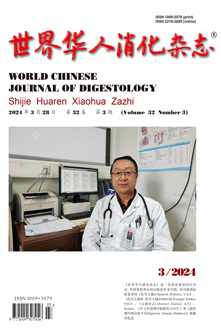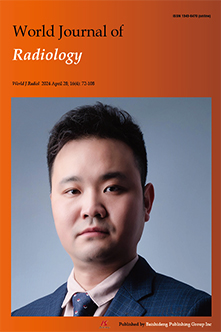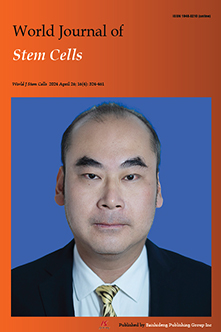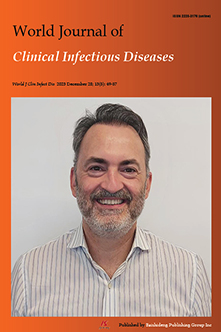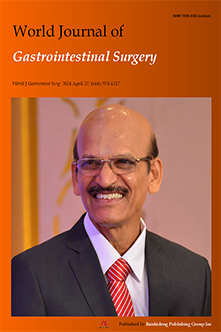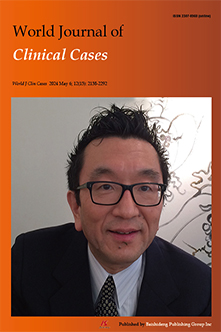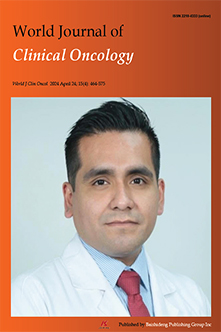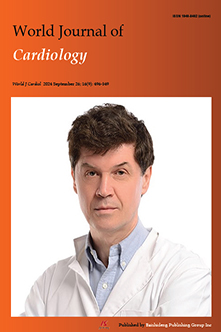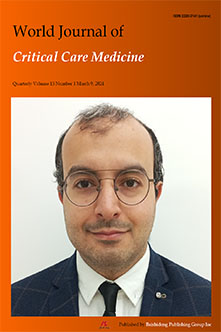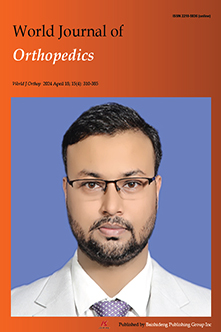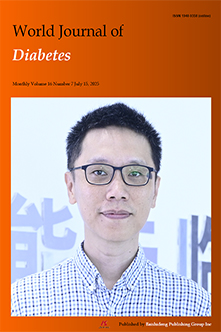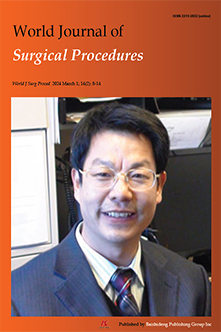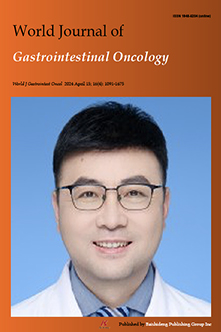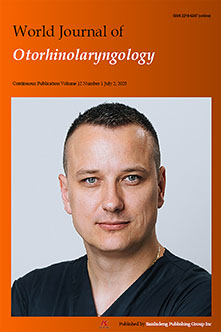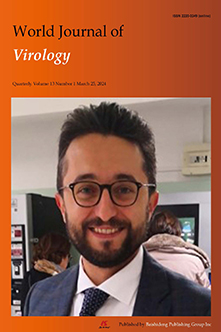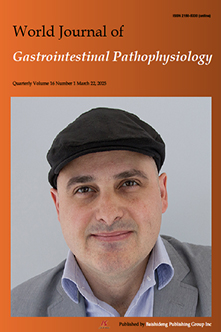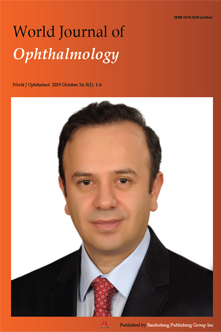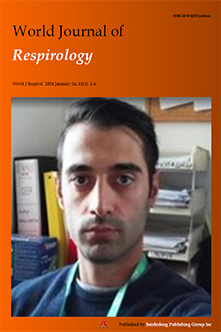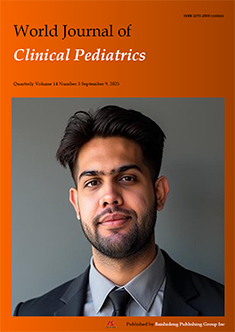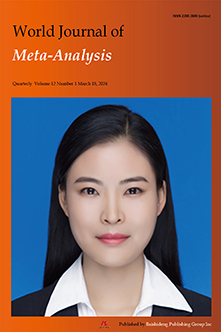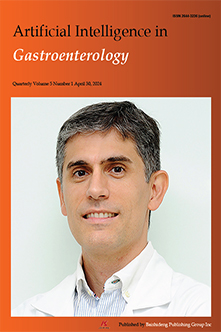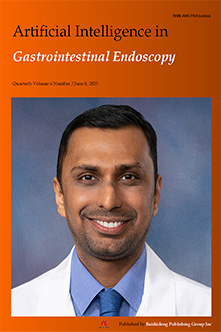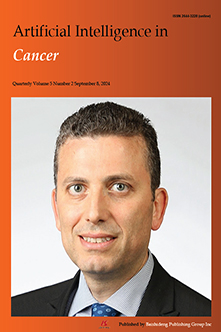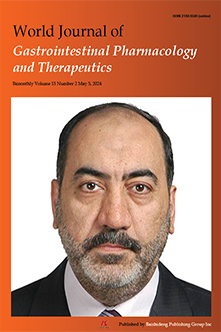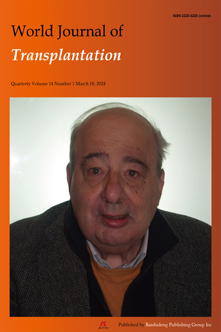Publisher Login
Manuscript Statistics
1
2
3
4
5
6
7
8
9
10
11
12
13
14
15
16
2025-07-24 | Browse: 22 | Download: 0
17
18
19
20
596 items Read more >>
1
"The process of submitting is relatively easy. Maybe some steps (like specific reference formatting) could be omitted to make it even ..."
[Read more]
"The process of submitting is relatively easy. Maybe some steps (like specific reference formatting) could be omitted to make it even faster and easier for authors to submit their work. Most importantly, the editors and staff's responses and assistance were always helpful and to the point. I look forward to more publications with the World Journal of Radiology. Thank you very much, and I hope we will work together again in the near future. "
[Collapse]
Arkoudis NA, Karachaliou A, Triantafyllou G, Papadopoulos A, Koutserimpas C, Velonakis G. Spinal cord ischemia: The “snake bite sign”. World J Radiol 2025; 17(7): 110385
2
"The process of manuscript prepataion was objective and helped me. The editorial team was in very operative contact with me. Sometimes ..."
[Read more]
"The process of manuscript prepataion was objective and helped me. The editorial team was in very operative contact with me. Sometimes the help desk didn't reply and then I apllied directly to editorial team. I appreciated for the big patiency of editorial team. I have an ask and suggestion for the manuscript preparation - it will be useful for authors if the language editing will provide the editorial team for proper payment. Thank you. "
[Collapse]
Hakobyan VM, Petrosyan AA, Yeghiazaryan HH, Aleksanyan AY, Safaryan HH, Shmavonyan HH, Papazyan KT, Ayvazyan KH, Davtyan LG, Khachatryan AA, Sargsyan GS, Stepanyan SA. Removal of the sac during surgery for the repair of “giant” paraesophageal hernias. World J Gastrointest Surg 2025; 17(7): 106365
3
"We are very satisfied with the editorial and peer review process of this journal. The online submission system was user-friendly and ..."
[Read more]
"We are very satisfied with the editorial and peer review process of this journal. The online submission system was user-friendly and efficient. The peer review reports were professional, constructive, and provided valuable guidance that helped us improve the quality of our manuscript. The editorial team maintained excellent communication throughout the process, and the final production quality, including formatting of figures and tables, met high academic standards. We appreciate the rigorous academic norms and the timely publication. We look forward to future collaboration with the journal. "
[Collapse]
Zhou Y, Xu BT, Zhou HY, Shang ZT. Long noncoding ribonucleic acid ENST00000517482 enhances mesenchymal stem cell therapy against acute lung injury. World J Stem Cells 2025; 17(7): 109064
4
"Overall, this peer review process is efficient and professional. The review didn't take an unreasonably long time, so it didn't hold ..."
[Read more]
"Overall, this peer review process is efficient and professional. The review didn't take an unreasonably long time, so it didn't hold back the progress of my research. The anonymous review mechanism effectively avoids subjective interference and ensures a fair environment. The review reports are highly targeted. They carefully point out areas for improvement, from refining research methods to tightening up the logic of conclusions, clearly guiding me in polishing the manuscript. Whether it's recognizing the innovation of the research or rigorously examining data details, the reviews demonstrate fairness and objectivity, helping me significantly enhance the quality of my manuscript. I'm looking forward to future collaborations with the journal and hope such a high - quality review model will continue to support academic exchanges. "
[Collapse]
Wang K, Lin W, Han JY, Chen JY, Liu RH, Yu Z, Jin JJ. Differentiation of patient-specific induced pluripotent stem cells derived from type 1 diabetes peripheral blood mononuclear cells into pancreatic β-like cells. World J Stem Cells 2025; 17(7): 104607
5
"The World journal of gastrointestinal oncology has an excellent review process, no other problem with responses, the editorial team ..."
[Read more]
"The World journal of gastrointestinal oncology has an excellent review process, no other problem with responses, the editorial team is accessible, and helps the process to be fast. The World journal of gastrointestinal oncology has an excellent review process, no other problem with responses, the editorial team is accessible, and helps the process to be fast. "
[Collapse]
Pires AC, Uson Junior PLS. Enhancing T-cell response with monoclonal antibodies and chemotherapy in advanced gastric cancer. World J Gastrointest Oncol 2025; 17(7): 104806
6
"This editorial was our effort to critically appraise a basic study published in the World J Gastroenterol and we are very happy with ..."
[Read more]
"This editorial was our effort to critically appraise a basic study published in the World J Gastroenterol and we are very happy with the editing process, peer reviews and article publishing process. The Journal is in its progressive journey with a higher impact factor this year and one of the reason is the quality of papers published in the WJG and we wish a better future to the Journal. Professor Joseph M Pappachan MD. FRCP, Corresponding author. "
[Collapse]
Fernandez CJ, Jena S, Lakshmi V, Pappachan JM. Duodenal mucosal ablation: An emerging therapeutic concept for metabolic dysfunction-associated fatty liver disease. World J Gastroenterol 2025; 31(28): 109468
7
"All authors sincerely appreciate the professional and efficient publication process with World Journal of Gastroenterology. The ..."
[Read more]
"All authors sincerely appreciate the professional and efficient publication process with World Journal of Gastroenterology. The editorial team maintained timely communication, and the reviewers provided constructive and insightful suggestions that helped improve the quality of our manuscript. We are grateful for the journal’s support and look forward to future collaboration. "
[Collapse]
Ma L, Zhang MH, Xu YF, Hao YX, Niu XX, Li Y, Xing HC. Fecal microbiota transplantation: A promising treatment strategy for chronic liver disease. World J Gastroenterol 2025; 31(28): 105089
8
"I am extremely satisfied with the entire publication process at World Journal of Gastroenterology ! From submission to final ..."
[Read more]
"I am extremely satisfied with the entire publication process at World Journal of Gastroenterology ! From submission to final publication, the editorial team maintained efficient and professional communication throughout. The reviewers provided rigorous yet constructive feedback that significantly improved the quality of the manuscript. The online submission system was user-friendly, the publication timeline was remarkably fast, and the layout design is clear and visually appealing. Particularly commendable is the journal's open-access policy, which ensures wide dissemination of research findings. I sincerely appreciate the high-quality service WJG provides to authors and its outstanding platform for showcasing academic work in the field of gastroenterology. I look forward to future collaborations with this esteemed journal! "
[Collapse]
Wu HY, Han L, Ran T, Sun Y, Zhang QX, Huang T, Zou GL, Zhang Y, Zhou YM, Lin GY, Chen SJ, Wang JL, Pan C, Lu F, Pu HF, Zhao XK. FBP1 as a key regulator of focal adhesion kinase-mediated hepatic stellate cell activation: Multi-omics and experimental validation. World J Gastroenterol 2025; 31(28): 107361
9
"We sincerely appreciate the support and guidance provided by the journal throughout the invitation and peer-review process. The entire ..."
[Read more]
"We sincerely appreciate the support and guidance provided by the journal throughout the invitation and peer-review process. The entire experience was smooth, professional, and well-organized. As a small suggestion, we believe the overall publication workflow could benefit from a slightly faster transition between the peer review and final publication stages. "
[Collapse]
Li YH, Yao YN, Zhou SA, Wang Y. Regulation and intervention of stem cell differentiation by long non-coding RNAs: Mechanisms and therapeutic potential. World J Stem Cells 2025; 17(7): 107688
10
"All authors would like to express their gratitude to the reviewers of this thesis for their professional review comments, the ..."
[Read more]
"All authors would like to express their gratitude to the reviewers of this thesis for their professional review comments, the modifications suggested by the reviewers are very helpful in improving the quality of this thesis; and to the editorial board for their professional editorial comments, and for their hard work and selflessness. "
[Collapse]
Kang LM, Zhao YH, Yu FK, Zhang FW, Kang X. Two-point lifting/retracting technology for transumbilical single-port laparoscopic cholecystectomy based on the anatomical features of Calot's triangle. World J Gastrointest Surg 2025; 17(7): 104261
11
"I would like to express my sincere gratitude to the editorial team and the reviewers for their constructive feedback, professionalism, ..."
[Read more]
"I would like to express my sincere gratitude to the editorial team and the reviewers for their constructive feedback, professionalism, and kind support throughout the entire publication process. From the initial submission to the final decision, every step was handled with transparency and efficiency, which greatly contributed to a positive and reassuring experience as an author. The reviewers’ insightful comments not only helped improve the quality of the manuscript but also demonstrated a genuine engagement with the research topic. I am truly pleased to have had the opportunity to publish in this journal, and I appreciate the commitment to scientific rigor and author support that was evident at every stage "
[Collapse]
Sengul Bag F, Bag OF. Molecular and therapeutic effects of mesenchymal stem cell-derived exosomes on autoimmune diseases. World J Stem Cells 2025; 17(7): 107202
12
"The editors are conscientious and responsible, making the entire submission experience extremely smooth. They handle manuscripts and ..."
[Read more]
"The editors are conscientious and responsible, making the entire submission experience extremely smooth. They handle manuscripts and various requests with high efficiency. What is particularly worth mentioning is that the submission system integrated with artificial intelligence technology has brought a great deal of convenience, significantly reducing the operational difficulties in the submission process. "
[Collapse]
Ma WG, Si YX, Zhang YL, Gao WF, Dong YG, Li YQ, Xu ZF, Xi Q, Li ZZ. Combining acupuncture and mesenchymal stem cell therapy offers promise as a treatment for inflammatory bowel disease. World J Stem Cells 2025; 17(7): 105371
13
"First, our study prompts us to rethink the current indications for treatment. The conventional 'watchful waiting' strategy carries ..."
[Read more]
"First, our study prompts us to rethink the current indications for treatment. The conventional 'watchful waiting' strategy carries risk. Our data shows 63% of our patients sought treatment precisely because their tumors grew during this observation period, potentially missing the optimal window for intervention. We propose that dynamic tumor growth and patient anxiety should be considered key indications for intervention, and that MDT evaluation is essential for these personalized decisions. Next, our study answers a core question of safety. We all know the greatest risk of standalone MWA is severe hemolysis. Our data demonstrates that pre-treatment with TACE eliminated this key complication. The mechanism is clear: TACE devascularizes the tumor, overcoming the 'heat sink effect' and enabling a safer procedure. With this safety bottleneck solved, efficacy was also dramatically improved. I also want to address the evaluation criteria. The standard RECIST criteria look only at 'size.' However, after our therapy, the tumor becomes a non-viable 'scar,' so measuring only size underestimates the true effect. We believe that for this therapy, the mRECIST criteria, which assess tumor 'viability,' provide a much more accurate reflection of success. Finally, our success extends beyond the images; it translates into tangible clinical benefits. Pre-treatment, nearly a third of patients were symptomatic. Post-treatment, the symptom improvement rate was approximately 93%. We also addressed the psychological burden, with a majority of anxious patients showing improvement. This demonstrates our strategy doesn't just treat a lesion—it restores patient well-being." Our study has several limitations, primarily its retrospective, single-center design and limited sample size. In conclusion, combining TACE with MWA is a safer and more effective strategy than TACE alone for large hepatic hemangiomas. These results provide a strong rationale for prospective, multicenter trials to establish this combination as a new standard of care. "
[Collapse]
Sun JP, Zhou K, Pan J, Yang N, Sun XN, Zhao HT, Yang XB. Efficacy and safety of transcatheter arterial chemoembolization combined with microwave ablation for hepatic hemangiomas (> 5 cm). World J Gastroenterol 2025; 31(28): 109078
14
"The experience of publishing a paper in World Journal of Clinical Cases was impressive. The entire process was efficient and ..."
[Read more]
"The experience of publishing a paper in World Journal of Clinical Cases was impressive. The entire process was efficient and transparent, fully demonstrating the professionalism and author-friendliness of a reputable journal. The submission system had a clear interface and was easy to operate. The status of the manuscript was updated in real time, greatly enhancing communication efficiency. The processing speed of the editorial department was commendable, with a prompt initial review and clear feedback. The reviewers' comments were detailed and to the point, directly addressing key issues and providing significant support for improving the quality of the paper. During the revision process, the editorial team was patient and coordinated well, responding promptly and meticulously to any questions, ensuring the accuracy and completeness of the revised manuscript. The final online publication and typesetting process was smooth and standardized, fully respecting the integrity of the academic work. "
[Collapse]
Cheng LL, Tang B, Liu H, Zhu F, Chen YF, Zhang W. Thoughts and challenges of giant retroperitoneal liposarcoma: A case report. World J Clin Cases 2025; 13(26): 108308
15
"We sincerely thank the editorial team and reviewers of the World Journal of Clinical Oncology for their valuable time, critical ..."
[Read more]
"We sincerely thank the editorial team and reviewers of the World Journal of Clinical Oncology for their valuable time, critical feedback, and support throughout the review process of our manuscript (Manuscript No: 107007). We are pleased to see our review article published and believe it will contribute meaningfully to the current understanding and future directions in clinical oncology. We appreciate the opportunity to share our work with the global scientific community and look forward to continued collaboration with the journal in the future. "
[Collapse]
Gharia J, Pimplaskar S, Prajapati A. Revolutionizing cancer care: Bioprinting prostate cancer stem cells for targeted treatments. World J Clin Oncol 2025; 16(7): 107007
16
"We sincerely thank the editorial team and reviewers of the World Journal of Clinical Oncology for their valuable time, critical ..."
[Read more]
"We sincerely thank the editorial team and reviewers of the World Journal of Clinical Oncology for their valuable time, critical feedback, and support throughout the review process of our manuscript (Manuscript No: 107788). We are pleased to see our review article published and believe it will contribute meaningfully to the current understanding and future directions in clinical oncology. We appreciate the opportunity to share our work with the global scientific community and look forward to continued collaboration with the journal in the future. "
[Collapse]
Rana TA, Prajapati A. Unleashing the potential of ferroptosis, autophagy, and mitochondrial dynamics as emerging modalities in cancer treatment. World J Clin Oncol 2025; 16(7): 107788
17
"This is my 16th publication and I have submitted close to 50 papers. The professional services and excellent SOPs never cease to amaze ..."
[Read more]
"This is my 16th publication and I have submitted close to 50 papers. The professional services and excellent SOPs never cease to amaze me. I rate this group as one of the best across the globe. That's the reason that I prefer to submit my best papers in this group first. "
[Collapse]
Garg P, Tulina I, Ren DL, Bhattacharya K, Yagnik VD, Mahak G. TONEFACT: Can even advanced hemorrhoids be treated without surgery? A paradigm shift in the management of hemorrhoids. World J Gastrointest Surg 2025; 17(7): 107099
18
"The publication process was highly professional, and I appreciated the clarity, responsiveness, and continuous support provided ..."
[Read more]
"The publication process was highly professional, and I appreciated the clarity, responsiveness, and continuous support provided throughout all stages. The evaluation system is well-structured and transparent, reflecting the journal’s strong commitment to scientific quality, editorial excellence, and a positive author experience. I felt that my work was handled with great care and respect, and I am grateful for the collaborative atmosphere fostered by the editorial team "
[Collapse]
Sawaied IO, Samson AO, Golan E. Perceived risk of gastric cancer associated with long-term use of proton pump inhibitors: Bridging the gap. World J Clin Oncol 2025; 16(7): 107091
19
"Thanks to the efforts of the editorial team, this article has finally been published. We would like to express our gratitude to the ..."
[Read more]
"Thanks to the efforts of the editorial team, this article has finally been published. We would like to express our gratitude to the editors for their hard work and assistance, and to the reviewers for their valuable feedback, which has made the article even more perfect. I hope the article can bring useful information to readers and open up new scientific ideas. "
[Collapse]
Lin J, Chen YY, Wang SJ, Zhang Y, Huang HS, Zhang XQ. Epigenetic clocks of female reproductive system aging: Current application and future prospects. World J Obstet Gynecol 2025; 14(2): 108149
20
"We sincerely appreciate the efficient and transparent editorial process provided by the Baishideng Publishing Group. The peer review ..."
[Read more]
"We sincerely appreciate the efficient and transparent editorial process provided by the Baishideng Publishing Group. The peer review was constructive, timely, and significantly enhanced the quality of our manuscript on intestinal ultrasound in ulcerative colitis. We commend the editorial team for their professionalism and attention to detail throughout the publication workflow. "
[Collapse]
Pal P, Mateen MA, Pooja K, Rajadurai N, Gupta R, Tandan M, Duvvuru NR. Role of intestinal ultrasound in ulcerative colitis: A systematic review. World J Meta-Anal 2024; 12(3): 97210
19154 items Read more >>
1
"Fecal transplants have been reported to improve the intestinal flora and improve UC and Crohn’s disease. In recent years, it has been ..."
[Read more]
"Fecal transplants have been reported to improve the intestinal flora and improve UC and Crohn’s disease. In recent years, it has been reported that improving the intestinal flora improves liver damage. This is very interesting data, and it is believed that improving the intestinal flora improves bile acids and liver function. Please explain the mechanism behind this."
[Collapse]
Ma L, Zhang MH, Xu YF, Hao YX, Niu XX, Li Y, Xing HC. Fecal microbiota transplantation: A promising treatment strategy for chronic liver disease. World J Gastroenterol 2025; 31(28): 105089
2
"The article “Stem cell therapy for diabetes: Advances, prospects, and challenges” provides a concise and informative overview of ..."
[Read more]
"The article “Stem cell therapy for diabetes: Advances, prospects, and challenges” provides a concise and informative overview of current developments in stem cell–based approaches to treating diabetes, with a particular focus on induced pluripotent stem cells (iPSCs), mesenchymal stem cells (MSCs), and pancreatic islet transplantation. Zuo et al. present the current state of research, acknowledging both the exciting advancements and the persistent challenges. However, in some cases, the discussion leans toward emphasizing successful studies and positive trial outcomes, occasionally lacking a rigorous critique of failures or contradictory findings in the field. Thus, many of the cited studies report favorable outcomes, with limited discussion of trials that yielded null results or failed to translate to clinical efficacy.
Authors clearly explain the underlying biological mechanisms, such as β-cell differentiation and paracrine immunomodulation by MSCs. Noteworthy advances are documented, including CRISPR-mediated immune evasion strategies, the development of encapsulation technologies to protect transplanted cells from host immunity, and the application of bioprinting to improve islet viability and function. The authors effectively describe the transition from basic research to clinical application, citing the first-in-human trials and the survival of stem cell–derived islets for over one year in patients. These contributions add clarity and momentum to the translational landscape of regenerative diabetes therapies.
Authors also acknowledges unresolved issues that remain major barriers to clinical translation. These include the risks of tumorigenicity associated with iPSCs, the low engraftment efficiency of transplanted cells, and ongoing challenges with host immune rejection. Furthermore, the absence of long-term safety and efficacy data from randomized controlled trials highlights the need for more rigorous evidence before widespread adoption. The authors propose future directions such as 3D bioprinting of organoids, AI-guided combination therapies, and further refinement of genome editing techniques to enhance safety and immune compatibility.
In conclusion, this review offers a well-informed and timely synthesis of the rapidly evolving field of stem cell therapy for diabetes. It successfully highlights promising technologies and recent clinical breakthroughs while acknowledging the complexity of translating laboratory innovations into durable, safe, and accessible therapies. Future iterations of this work would benefit from deeper critical analysis of contradictory evidence, expanded discussion on regulatory and ethical frameworks, and integration of emerging clinical trial data. Such enhancements would further strengthen its contribution to the scientific community and aid in shaping the direction of next-stage research and therapeutic development."
[Collapse]
Zuo DB, Wang CH, Sang M, Sun XD, Chen GP, Ji KK. Stem cell therapy for diabetes: Advances, prospects, and challenges. World J Diabetes 2025; 16(7): 107344
3
"There is an Ethical problems, because hepatic hemangioma is benign tumor and it does not require any treatment. Transcatheter arterial ..."
[Read more]
"There is an Ethical problems, because hepatic hemangioma is benign tumor and it does not require any treatment. Transcatheter arterial chemoembolization (TACE) and microwave ablation (MWA) have an adverse events, and so authors should make clear the definition of hepatic hemangioma which needs treatment. Authors only described the prognosis after 12 months. Authors should report the longer prognosis.
"
[Collapse]
Sun JP, Zhou K, Pan J, Yang N, Sun XN, Zhao HT, Yang XB. Efficacy and safety of transcatheter arterial chemoembolization combined with microwave ablation for hepatic hemangiomas (> 5 cm). World J Gastroenterol 2025; 31(28): 109078
4
"Well written manuscript, providing a detailed overview of MPox in neonates, including clinical presentation and particularities in ..."
[Read more]
"Well written manuscript, providing a detailed overview of MPox in neonates, including clinical presentation and particularities in this age group, diagnosis, treatment options and therapeutic considerations, public health challenges and future implications. Specific mention of differential diagnostic consideration is also appreciated.
Reference list is relevant and complete and the quality of language is good.
Although I understand that MPox is rare in children, I'd suggest if possible to add some statements on the current epidemiology of MPox in this age group, or if it is only limited to case reports.
"
[Collapse]
Ikram E, Shaukat A, Qureshi MS, Saifullah M, Aslam MA, Mehdi AM. Monkeypox in neonates: A narrative review on clinical presentations, vertical transmission, and treatment challenges. World J Clin Infect Dis 2025; 14(1): 109806
5
"Vonoprazan (VPZ) is a new potassium antagonist that inhibits gastric acid secretion by blocking the binding of H+/K+-ATPase to K+ ..."
[Read more]
"Vonoprazan (VPZ) is a new potassium antagonist that inhibits gastric acid secretion by blocking the binding of H+/K+-ATPase to K+ and preventing the entry of H+ into the gastric lumen. Existing studies demonstrate that VPZ-based treatment regimens, including triple therapy regimens with VPZ, amoxicillin, and clarithromycin, are both safe and effective in eradicating H. pylori. The multicenter randomized controlled trial discussed here was the first to compare triple therapy based on VPZ (VPZ/amoxicillin/clarithromycin) with the 14-day quadruple regimen based on bismuth in China. The results showed that triple therapy with VPZ achieved higher eradication rates compared to the quadruple regimen and with similar rates of side effects, making triple therapy with VPZ an important alternative (without bismuth) for eradicating H. pylori. Interestingly, no significant differences in eradication rates were observed between the 10- and 14-day treatments. However, to optimize results and reduce the incidence of antibiotic resistance, it is necessary to conduct extensive, multicenter studies in various countries worldwide."
[Collapse]
Han RS, Hao JW, Wang T, Xin Z, Fan GX, Wang GD, Liu MM, Liu CX, Yang QZ, Yang ZW, Lv XY, Zhang C, Bian G, Meng J, Cui ZQ, Yun XJ, Cao JH, Li SH, Fan JF, Ma HG, Gao FY, Mao T, Tian ZB, Song XH, Yu YN. Efficacy and safety of triple therapy with vonoprazan for Helicobacter pylori eradication: A multicenter, prospective, randomized controlled trial. World J Gastroenterol 2025; 31(28): 109001
6
"The minireview "Key players in the breast cancer microenvironment: From fibroblasts to immune cells" by Sacide et al summarizes the ..."
[Read more]
"The minireview "Key players in the breast cancer microenvironment: From fibroblasts to immune cells" by Sacide et al summarizes the role of tumor microenvironment in the immune invasion, therapy resistance and metastasis process in Breast cancer. This understanding will definitely help us to explore the breast cancer progression with new therapeutic approach. The minireview is well written and beautifully presented. The language and grammar is appropriate. The referencing is good.
However, a description on role of tumor microenvironment on angiogenesis and angiogenic signaling could have been discussed.
Overall The review is good and useful for the scientific community."
[Collapse]
Çakal S, Er Urgancı B, Şimşek S. Key players in the breast cancer microenvironment: From fibroblasts to immune cells. World J Clin Oncol 2025; 16(7): 107339
7
"This study concerns a consensus reached by a group of experts from the Middle East, who, with the assistance of an internationally ..."
[Read more]
"This study concerns a consensus reached by a group of experts from the Middle East, who, with the assistance of an internationally recognized German expert, formulated comprehensive guidelines on the treatment of Helicobacter pylori infection in the Middle East. It is well known that the prevalence of Helicobacter pylori infection in these countries is quite high in both adults and children. The development of antibiotic resistance in these countries is another obstacle to the effectiveness of treatment. In this sense, the formulation of these guidelines for treating Helicobacter pylori infection is useful and of practical importance, particularly about the risk of developing gastric cancer. Such activities should also be carried out in other parts of the world (e.g., Africa, Asia)."
[Collapse]
Sharara AI, Alsohaibani FI, Alsaegh A, Al Ejji K, Al Awadhi S, Malfertheiner P, Karam SA, Al-Taweel T. First regional consensus on the management of Helicobacter pylori infection in the Middle East. World J Gastroenterol 2025; 31(27): 107138
8
"This is very interesting paper about heart failure after TIPS.Heart failure can be a complication after a transjugular intrahepatic ..."
[Read more]
"This is very interesting paper about heart failure after TIPS.Heart failure can be a complication after a transjugular intrahepatic portosystemic shunt (TIPS) procedure, particularly in patients with pre-existing heart conditions or those with cirrhotic cardiomyopathy. While post-TIPS heart failure is relatively uncommon, it is crucial to understand the factors that can contribute to its development and to monitor patients closely for signs and symptoms. The author's fig4 EKG, BNP, and echocardiographic evaluations are simple and easy to understand."
[Collapse]
Tomassoni DR, Schildkraut T, Ramachandran V, Cooke JC, Sawhney R. Cardiovascular risk assessment and predictors of cardiac decompensation after transjugular intrahepatic portosystemic shunt in patients with cirrhosis. World J Gastroenterol 2025; 31(27): 107740
9
"Kwon et al. reported that deep learning-based localization and lesion detection in capsule endoscopy for patients with suspected ..."
[Read more]
"Kwon et al. reported that deep learning-based localization and lesion detection in capsule endoscopy for patients with suspected small-bowel bleeding. It maybe true the AI-based localization and lesion detection is very useful for the discovery of small-bowel bleeding in patients.
If possible, authors should distribute these application for everyone examine their figures. If so, everyone could recognize the results of authors."
[Collapse]
Kwon YS, Park TY, Kim SE, Park Y, Lee JG, Lee SP, Kim KO, Jang HJ, Yang YJ, Cho BJ. Deep learning-based localization and lesion detection in capsule endoscopy for patients with suspected small-bowel bleeding. World J Gastroenterol 2025; 31(27): 106819
10
"Excellently presented study. All points are very well taken. The article provides a comprehensive perspective on all contemporary ..."
[Read more]
"Excellently presented study. All points are very well taken. The article provides a comprehensive perspective on all contemporary aspects of variceal hemorrhage management. The article is written so that it is recommended for gastroenterologists, general surgeons, hospitalists, and emergency medicine physicians. The Authors' effort constitutes a major contribution towards updating the current knowledge and understanding of the problem, and provides a foundation for database perfection.
"
[Collapse]
Kogilathota Jagirdhar GS, Okafor CC, Hussain M, Elmati PR, Ghumman A, Shah M, Surani S. Decline of the Sengstaken-Blakemore tube: A review of shifting practices in gastrointestinal hemorrhage management. World J Crit Care Med 2025; 14(3): 101856
11
"Only three articles examined are very few, the search should be expanded. also missing the PROSPERO membership number and the PRISMA ..."
[Read more]
"Only three articles examined are very few, the search should be expanded. also missing the PROSPERO membership number and the PRISMA check-list. More detailed information on research should be provided to make it more rigorous. It would also be useful to specify the limitations of the study and what can be done in future studies to improve these limits Finally , a English editing is needed."
[Collapse]
Yousif Mohamed AM, Salih M, Mohamed M, Abbas AE, Elsiddig M, Osama Omar M, Abdelsalam M, Elhag B, Mohamed N, Eisa Ahmed SH, Ahmed S, Mohamed D, Omar D. Comparative efficacy of cementless bipolar hemiarthroplasty and proximal femoral nail anti-rotation in unstable intertrochanteric fractures: A meta-analysis. World J Orthop 2025; 16(7): 107950
12
"Survival rates following radical surgery for gastric neuroendocrine neoplasms (g-NENs) are low, with high recurrence rates. Liu, et ..."
[Read more]
"Survival rates following radical surgery for gastric neuroendocrine neoplasms (g-NENs) are low, with high recurrence rates. Liu, et al’s study addressed a critical issue in determining the postoperative prognosis of gastric neuroendocrine tumors by identifying the significance of lymph node ratio. Moreover, the random survival forest model, a machine-learning approach, surpasses traditional Cox proportional hazards models by enhancing predictive accuracy, clinical utility, and overall performance. This model’s ability to stratify patient risks and personalize survival predictions can aid in formulating targeted postoperative strategies, thus realizing an important aspect of personalized “precision medicine”. This paper is indicative for journal readers in this field."
[Collapse]
Wang HN, An JH, Zong L. Estimating prognosis of gastric neuroendocrine neoplasms using machine learning: A step towards precision medicine. World J Gastrointest Oncol 2024; 16(12): 4548-4552
13
"Hepatocellular carcinoma (HCC) is one of the leading causes of cancer-related deaths due to late diagnosis and high recurrence rates. ..."
[Read more]
"Hepatocellular carcinoma (HCC) is one of the leading causes of cancer-related deaths due to late diagnosis and high recurrence rates. Key biomarkers such as enhancer of zeste homolog 2 and fatty acid binding protein 5, along with other genetic biomarkers provide insights into HCC progression and potential therapeutic targets. This paper is indicative for journal readers in this field.
"
[Collapse]
Shodry S, Hasan YTN, Ahdi IR, Ulhaq ZS. Gene targets with therapeutic potential in hepatocellular carcinoma. World J Gastrointest Oncol 2024; 16(12): 4543-4547
14
"In this Editorial we comment on the interesting article by Liu, et al. The controlling nutritional status (CONUT) score was ..."
[Read more]
"In this Editorial we comment on the interesting article by Liu, et al. The controlling nutritional status (CONUT) score was significantly associated with the prognosis of colorectal cancer patients, as supported by a large body of literature. Compared with other nutritional scores, the CONUT score might be introduced in clinical practice as an optimal prognostic nutritional index to predict patient outcome."
[Collapse]
Berardi R, Chiariotti R, Mentrasti G. Is nutritional status a new indicator to use in clinical practice for colorectal cancer patients? World J Gastrointest Oncol 2024; 16(12): 4537-4542
15
"In this Editorial, they highlighted potential pitfalls in the current classification of mixed neuroendocrine non-neuroendocrine ..."
[Read more]
"In this Editorial, they highlighted potential pitfalls in the current classification of mixed neuroendocrine non-neuroendocrine neoplasms and commented on challenges in the management of this heterogeneous group of malignancies in light of the paucity of evidence in the field. Improved biological and clinical knowledge were needed to generate robust classification schemes that will in turn provide clarity on the epidemiology of the disease, prognosis of affected patients and guidance for treatment tailoring. This paper is indicative for journal readers in this field."
[Collapse]
Cives M, Porta C, Palmirotta R. Mixed neuroendocrine non-neuroendocrine tumors: The quest for evidence. World J Gastrointest Oncol 2024; 16(12): 4532-4536
16
"Gastric cancer remains a formidable global health concern with significant morbidity and mortality rates, despite the fact that ..."
[Read more]
"Gastric cancer remains a formidable global health concern with significant morbidity and mortality rates, despite the fact that numerous advances have been made to improve conventional therapies. This Editorial article integrated network pharmacology insights with rigorous experimental validation to highlight the potential of Xiaojianzhong decoction as a multifaceted therapeutic approach for gastric cancer. This paper is indicative for journal readers in this field."
[Collapse]
Cheng CH, Hao WR, Cheng TH. Exploring Xiaojianzhong decoction's potential in gastric cancer treatment: Integrative insights and experimental validation. World J Gastrointest Oncol 2024; 16(12): 4553-4558
17
"Mixed neuroendocrine non-neuroendocrine neoplasms constitute rare tumors that are located mainly in the gastrointestinal tract and ..."
[Read more]
"Mixed neuroendocrine non-neuroendocrine neoplasms constitute rare tumors that are located mainly in the gastrointestinal tract and have high degrees of malignancy, and the frequency of these tumors has been increasing. The rare but steadily increasing number of gastrointestinal mixed neuroendocrine non-neuroendocrine neoplasms and pure neuroendocrine carcinomas require more radical treatment than slow-growing neuroendocrine neoplasms do and they are related to poor prognosis. They constitute a complicated diagnostic and therapeutic challenge. The current management strategy begins with surgery and is followed by chemotherapy. New chemotherapeutics and novel biological agents for targeted therapy, along with immunotherapy broaden the range of therapeutic options, providing promising outcomes. Effective management should be individualized and multidisciplinary. This paper is indicative for journal readers in this field."
[Collapse]
Pavlidis ET, Galanis IN, Pavlidis TE. Critical considerations for the management of gastrointestinal mixed neuroendocrine non-neuroendocrine neoplasms and pure neuroendocrine carcinomas. World J Gastrointest Oncol 2024; 16(12): 4559-4564
18
"Within the intricate milieu of colorectal cancer (CRC) tissues, cancer-associated fibroblasts (CAFs) act as pivotal orchestrators, ..."
[Read more]
"Within the intricate milieu of colorectal cancer (CRC) tissues, cancer-associated fibroblasts (CAFs) act as pivotal orchestrators, wielding considerable influence over tumor progression. Their review endeavored to dissect the multifaceted functions of CAFs within the realm of CRC, thereby highlighting their indispensability in fostering CRC malignant microenvironment and indicating the development of CAFs-targeted therapeutic interventions. Through a comprehensive synthesis of current knowledge, their review delineated insights into CAFs-mediated modulation of cancer cell proliferation, invasiveness, immune evasion, and neovascularization, elucidating the intricate web of interactions that sustain the pro-tumor metabolism and secretion of multiple factors. Additionally, recognizing the high level of heterogeneity within CAFs is crucial, as they encompass a range of subtypes, including myofibroblastic CAFs, inflammatory CAFs, antigen-presenting CAFs, and vessel-associated CAFs. Innovatively, the symbiotic relationship between CAFs and the intestinal microbiota is explored, shedding light on a novel dimension of CRC pathogenesis. Despite remarkable progress, the orchestrated dynamic functions of CAFs remain incompletely deciphered, underscoring the need for continued research endeavors for therapeutic advancements in CRC management. This review article is well written, and is informative for journal readers in this field."
[Collapse]
Cui JY, Ma J, Gao XX, Sheng ZM, Pan ZX, Shi LH, Zhang BG. Unraveling the role of cancer-associated fibroblasts in colorectal cancer. World J Gastrointest Oncol 2024; 16(12): 4565-4578
19
"In their report, they assessed the prognostic value of gamma-glutamyl transpeptidase to platelet ratio (GPR) in early hepatitis B ..."
[Read more]
"In their report, they assessed the prognostic value of gamma-glutamyl transpeptidase to platelet ratio (GPR) in early hepatitis B virus (HBV)-related hepatocellular carcinoma (HCC) patients. They evaluated the clinical utility of preoperative GPR in predicting outcomes for solitary HBV-related HCC patients using propensity score matching, restricted cubic spline, survival analyses and stratified analyses. Preoperative GPR levels facilitated recurrence monitoring and inform treatment strategies, potentially enhancing the quality of life for HCC patients. Although case report accompanied with some limitations for any conclusions, their report is interesting for journal readers in this field."
[Collapse]
Yang CK, Wei ZL, Shen XQ, Jia YX, Wu QY, Wei YG, Su H, Qin W, Liao XW, Zhu GZ, Peng T. Prognostic utility of gamma-glutamyl transpeptidase to platelet ratio in patients with solitary hepatitis B virus-related hepatocellular carcinoma after hepatectomy. World J Gastrointest Oncol 2024; 16(12): 4579-4596
20
"Their developed and validated a promising machine learning architecture for predicting the 3-category survival times (cutoff values ..."
[Read more]
"Their developed and validated a promising machine learning architecture for predicting the 3-category survival times (cutoff values of 3 years and 5 years) for four survival times (overall, disease-free, recurrence-free, and distant metastasis-free survival) and screened corresponding important variables. Fivefold cross validation and bootstrap validation were conducted. The models were evaluated with the area under the curve (AUC); moreover, the effectiveness of our variable screening methods was evaluated by comparing the models’ pre- and post-screening AUCs. SHapley Additive exPlanations were used to explain the decision-making process. Nomograms were drawn for various applications. Although their study design accompanied with some limitations for any conclusions, their results were informative for journal readers in this field."
[Collapse]
Ji XL, Xu S, Li XY, Xu JH, Han RS, Guo YJ, Duan LP, Tian ZB. Prognostic prediction models for postoperative patients with stage I to III colorectal cancer based on machine learning. World J Gastrointest Oncol 2024; 16(12): 4597-4613
15696 items Read more >>
Peer-Reviewers and Manuscript Statistics
- Editorial board members
- 2265
- Peer-reviewers
- 32522
- Manuscripts received today
- 9
- Manuscript reviews today
- 30
- Unhandled manuscripts today
- 128
- Active peer-reviewers today
- 1123
- Reviewer acceptance today
- 47
- Reviewer refusals today
- 46
- Total accepted manuscripts
- 36990
- Total rejected manuscripts
- 42446
- Total peer-reviewers
- 4298471
- Total submissions
- 35194
1
2
3
4
5
6
7
8
9
10
2025-09-20 | Browse: 8378 | Download: 990
11
2025-09-20 | Browse: 3623 | Download: 767
12
2025-09-20 | Browse: 4602 | Download: 782
13
14
2025-09-20 | Browse: 3634 | Download: 692
15
2025-09-20 | Browse: 4807 | Download: 744
16
2025-09-20 | Browse: 6172 | Download: 959
17
2025-09-20 | Browse: 4554 | Download: 717
18
2025-09-20 | Browse: 3984 | Download: 702
19
20
2025-09-20 | Browse: 4342 | Download: 744
59449 items Read more >>
70596 items Read more >>
1
"This research highlights the potential of NET-related markers as biomarkers for liver damage, offering a promising avenue for early ..."
[Read more]
"This research highlights the potential of NET-related markers as biomarkers for liver damage, offering a promising avenue for early diagnosis and therapeutic targeting. The study is particularly relevant given the global rise in metabolic diseases and liver conditions like MASLD. The inclusion of multiple models allows for a more comprehensive understanding of how different types of liver damage—fibrosis, steatohepatitis, and simple steatosis—affect systemic inflammation and NET formation. These findings could pave the way for novel treatment strategies focusing on regulating NETosis, which may be beneficial for clinical management of MASLD and related liver diseases. "
[Collapse]
Feješ A, Belvončíková P, Bečka E, Strečanský T, Pastorek M, Janko J, Filová B, Babál P, Šebeková K, Borbélyová V, Gardlík R. Myeloperoxidase, extracellular DNA and neutrophil extracellular trap formation in the animal models of metabolic dysfunction-associated steatotic liver disease. World J Gastroenterol 2025; 31(27): 106166
2
"This paper provides an insightful contribution to the field of MAFLD by developing a machine learning-based model for early detection ..."
[Read more]
"This paper provides an insightful contribution to the field of MAFLD by developing a machine learning-based model for early detection in high-metabolic-risk populations. The integration of clinical data and TCM features adds a unique, holistic perspective, which could enhance the model's diagnostic power. The use of advanced statistical methods, such as LASSO and RFE, strengthens the reliability of the predictive model. The XGBoost algorithm demonstrated superior performance, making it a promising tool for non-invasive MAFLD screening in clinical settings. Overall, the study presents a significant step towards improving MAFLD detection and has promising clinical implications, especially in cost-effective screening and early intervention for at-risk populations. "
[Collapse]
Tian Y, Zhou HY, Liu ML, Ruan Y, Yan ZX, Hu XH, Du J. Machine learning-based identification of biochemical markers to predict hepatic steatosis in patients at high metabolic risk. World J Gastroenterol 2025; 31(27): 108200
3
"Tian et al. (2025) present a compelling prospective observational study employing machine learning (ML) to identify biochemical and ..."
[Read more]
"Tian et al. (2025) present a compelling prospective observational study employing machine learning (ML) to identify biochemical and clinical markers predictive of hepatic steatosis in individuals at high metabolic risk. Metabolic-associated fatty liver disease (MAFLD) is prevalent yet frequently underdiagnosed, especially in early stages when traditional screening modalities like ultrasonography lack sensitivity. Thus, the authors’ development of a noninvasive, cost-effective ML-based predictive model is timely and clinically relevant, aiming for early identification and improved resource utilization. A methodological strength of the study is its comprehensive use of multiple ML algorithms—XGBoost, Random Forest (RF), Support Vector Machine (SVM), and Logistic Regression (LR)—representing diverse modeling approaches. This allowed for robust comparative analysis, with each algorithm selected for specific strengths: XGBoost for nonlinear interactions, RF for overfitting resistance, SVM for high-dimensional data, and LR for baseline interpretability. This methodological breadth effectively balances predictive performance and clinical practicality. To manage high-dimensional data (156 initial candidate features), the study employed dual feature selection techniques: recursive feature elimination (RFE) and Least Absolute Shrinkage and Selection Operator (LASSO) regression. Combining these strategies yielded a robust set of ten core features, significantly reducing complexity while ensuring predictive accuracy. These final predictors, including the AST/ALT ratio, triglycerides, and waist circumference, are clinically meaningful and closely correlate with hepatic steatosis, reinforcing the validity of their selection. Among the ML models evaluated, XGBoost demonstrated superior performance with an area under the ROC curve (AUC) of approximately 0.82, surpassing RF, SVM, and LR. XGBoost’s predictive strength was further validated through cross-validation (mean AUC ~0.918), suggesting robust internal consistency. Importantly, the model achieved high accuracy (84%) and an F1-score of 0.84, reflecting a balanced sensitivity and specificity crucial for clinical implementation. Another innovative aspect was incorporating Traditional Chinese Medicine (TCM) indicators alongside conventional clinical metrics. Two TCM-derived features, greasy tongue coating and tongue edge redness, emerged prominently among the top predictors, bridging traditional holistic diagnostics and contemporary data analytics. These TCM indicators likely represent underlying metabolic dysregulation consistent with “damp-heat” conditions in TCM theory, aligning with inflammation and metabolic dysfunction commonly observed in MAFLD. Incorporating TCM features provides valuable additional diagnostic perspectives, potentially capturing subtle clinical signs not represented in standard biomedical metrics. The quantitative integration of these features through digital analysis and expert validation represents a significant methodological innovation. However, several practical challenges must be considered. TCM diagnostic standardization and reproducibility outside controlled research settings may pose limitations. Differences in tongue appearance influenced by diet, hydration, and oral hygiene could introduce variability. Thus, ensuring consistent reproducibility and gaining broad clinical acceptance remain critical tasks for future research. Clinically, the authors’ ML tool holds significant promise for noninvasive screening, particularly valuable in routine healthcare settings where expensive or invasive procedures like MRI-PDFF or liver biopsies are impractical. This model’s reliance on common biochemical and clinical data enhances its applicability, particularly in resource-limited settings. Stratification by predicted risk allows targeted use of advanced imaging or specialist follow-up, optimizing clinical workflows and resource allocation. Nevertheless, the model’s limitations must be acknowledged. First, external validation in multicenter cohorts is essential, given the study’s single-center design and potential population-specific biases. Moreover, the lack of MAFLD subtyping overlooks disease heterogeneity, possibly limiting predictive accuracy for specific patient subsets (e.g., diabetic vs. non-diabetic patients, mild vs. severe steatosis). Addressing these nuances through subgroup-specific analyses or longitudinal follow-up studies will enhance interpretability and clinical utility. Future research could expand the feature set to include advanced biomarkers or imaging modalities to enhance predictive precision. Further, refining TCM integration through sophisticated image analysis or correlating TCM features with biochemical markers would provide stronger mechanistic insights. Prospective studies evaluating clinical outcomes of model-driven interventions, such as lifestyle modification or TCM-based therapies, could demonstrate tangible patient benefits and validate real-world clinical impact. In conclusion, Tian et al. present a robustly designed study introducing an innovative ML-based approach for early hepatic steatosis detection in high-risk populations. The inclusion of TCM diagnostic features exemplifies a novel integration of traditional medicine within contemporary predictive frameworks. Although initial results are promising, external validation, refinement for disease heterogeneity, and practical clinical integration remain critical next steps. This pioneering work significantly contributes to metabolic medicine and predictive hepatology, paving the way for improved, patient-centered management of fatty liver disease. "
[Collapse]
Tian Y, Zhou HY, Liu ML, Ruan Y, Yan ZX, Hu XH, Du J. Machine learning-based identification of biochemical markers to predict hepatic steatosis in patients at high metabolic risk. World J Gastroenterol 2025; 31(27): 108200
4
"This article provides forward-looking insights into liver disease treatment. It begins by accurately identifying the key factors ..."
[Read more]
"This article provides forward-looking insights into liver disease treatment. It begins by accurately identifying the key factors contributing to chronic liver diseases such as alcohol-associated liver disease, metabolic dysfunction-associated steatotic liver disease, and metabolic dysfunction-associated steatohepatitis, as well as the limitations of current treatments. This lays a solid foundation for subsequent innovative treatment ideas, helping readers clearly understand the existing challenges.When exploring solutions, it skillfully combines nanoparticles, gut microbiome modulation, and artificial intelligence, showcasing the immense potential of interdisciplinary integration. It lists various key types of nanocarriers, offering researchers abundant references, and elaborates on their diverse applications in modulating the gut microbiome for the treatment of chronic liver diseases, thereby broadening research perspectives.However, there is room for improvement in the details. For instance, the listed future challenges are somewhat vague. If each challenge were supported by more specific examples or data, the article would be more convincing. Additionally, a more in-depth explanation of how artificial intelligence precisely predicts treatment responses and enables personalized interventions could be beneficial, making it easier for readers without expertise in AI to understand.Overall, this article injects new vitality and hope into the field of liver disease treatment. It offers valuable insights for researchers and medical professionals. It is believed that these innovative therapeutic approaches will soon be applied in clinical practice, thereby enhancing patients' prognoses and quality of life. The article holds significant scientific and practical importance and is worthy of further research and attention. "
[Collapse]
Khurana A, Hartmann P. Gut microbiome-specific nanoparticle-based therapeutics for liver diseases. World J Gastroenterol 2025; 31(27): 109105
5
"In this commentary, we discuss the recent work by He et al. published in the World Journal of Gastroenterology, which identifies ..."
[Read more]
"In this commentary, we discuss the recent work by He et al. published in the World Journal of Gastroenterology, which identifies translocator protein (TSPO) as a novel player in the immunopathogenesis of inflammatory bowel disease (IBD), with a particular focus on neutrophil-driven ROS production and NET formation. The study highlights elevated TSPO expression in both the gut and peripheral neutrophils of IBD patients and further correlates this with increased neuroinflammatory signals in the brains of colitic mice. We commend the authors for linking gut and brain inflammation via TSPO, a mitochondrial protein long implicated in innate immune regulation. However, we offer several points for deeper consideration. Prior studies have shown that TSPO knockout in mice worsens DSS-induced colitis by enhancing macrophage pyroptosis, suggesting that TSPO may have cell-type–dependent functions. This contrasts with He et al.'s findings that TSPO antagonism reduces neutrophil ROS and NETs, raising questions about the net effects of modulating TSPO. We propose that future studies adopt cell-specific knockout models to clarify these roles. Additionally, we address the translational relevance of TSPO imaging in the CNS. In rodents, TSPO is upregulated in activated microglia; however, human data suggest that TSPO levels correlate more with immune cell density than activation state. This distinction is crucial when interpreting PET signals in IBD-associated brain inflammation. Moreover, astrocytic TSPO expression may contribute to these findings and deserves further discussion. We also suggest validating the current results in larger human cohorts, including through single-cell RNA sequencing and TSPO-PET studies. Investigating the behavioral and cognitive consequences of colitis-induced brain TSPO changes would further elucidate the gut-brain inflammatory axis. Finally, given the contradictory effects of different TSPO ligands (e.g., PK11195 vs. flunitrazepam), a pharmacological exploration of TSPO modulators with improved selectivity and safety is warranted. In conclusion, this letter supports the innovative perspective introduced by He et al., while also emphasizing the complexity of TSPO’s role across immune cell types and organ systems. A more nuanced understanding of TSPO biology may yield novel insights into both intestinal and neuroimmune pathologies. "
[Collapse]
He Q, Wu XH, Jiang DL, Lin RT, Xie F, Guan YH, Fei AH. Translocator protein facilitates neutrophil-mediated mucosal inflammation in inflammatory bowel diseases. World J Gastroenterol 2025; 31(27): 109239
6
"This study has applied a combined method of machine learning and regression analysis to evaluate the critical biomarkers in the ..."
[Read more]
"This study has applied a combined method of machine learning and regression analysis to evaluate the critical biomarkers in the diagnosis of Metabolic-associated fatty liver disease in patients. There are many correlated factors in this subsequent calculation under authors' efforts. We have considered these results to find a phenomenon that all these correlated factors coefficient values are not high. Hope that the author can explain them with scientific viewpoint. "
[Collapse]
Tian Y, Zhou HY, Liu ML, Ruan Y, Yan ZX, Hu XH, Du J. Machine learning-based identification of biochemical markers to predict hepatic steatosis in patients at high metabolic risk. World J Gastroenterol 2025; 31(27): 108200
7
"Crohn's disease (CD) is a chronic, relapsing inflammatory bowel disease that requires long-term treatment. Infliximab (IFX) plays ..."
[Read more]
"Crohn's disease (CD) is a chronic, relapsing inflammatory bowel disease that requires long-term treatment. Infliximab (IFX) plays an important role in inducing remission and maintaining treatment. However, the high incidence of secondary loss of response (SLOR) poses a significant challenge to disease control. Currently, clinical prediction methods for SLOR are limited, and traditional clinical indicators and imaging examinations are not precise enough for prediction. This study, through radiomics technology, integrates the features of the intestinal wall and creeping fat to develop a prediction model that may help identify high-risk patients in advance. This could facilitate earlier adjustment of treatment plans in clinical practice, prevent disease relapse or exacerbation due to SLOR, and reduce unnecessary treatment delays and waste of medical resources. In terms of research methodology, the retrospective analysis used in this study is feasible in practice and makes full use of existing clinical and imaging data. The clinical independent predictors identified through univariate and multivariate analyses, such as white blood cell count, disease duration, and Harvey-Bradshaw Index, are easily obtainable in daily clinical work and are consistent with the factors we clinically observe to be related to SLOR. This makes the study results more easily applicable in clinical practice. The extraction and analysis of radiomics features are also scientifically sound and reasonable. By considering both the intestinal wall and creeping fat, the study fully takes into account the pathological characteristics of Crohn's disease. Creeping fat, as one of the characteristic pathological changes of CD, is increasingly recognized for its role in disease progression and treatment response. Including it in the analysis provides new insights into understanding the pathophysiological mechanisms of CD. The research results are encouraging. The combined prediction model shows good predictive performance in both the training and validation cohorts, indicating high predictive accuracy. This means that the model is highly reliable in practical applications and can provide accurate SLOR risk assessments for clinicians. Through this model, patients can be divided into high-risk and low-risk subgroups to achieve individualized treatment management. For high-risk patients, we can strengthen monitoring, shorten follow-up intervals, and adjust treatment plans in a timely manner, such as increasing IFX dosage or shortening dosing intervals. For low-risk patients, the standard treatment plan can be maintained to avoid overtreatment. This individualized treatment strategy is expected to improve treatment outcomes and patient prognosis. However, the study also has some limitations. The sample size is relatively small, with only 220 patients from two centers included, which may limit the generalizability of the model. In actual clinical applications, patients from different regions and medical centers may vary, so further validation of the model's stability and accuracy is needed in larger-scale multicenter studies. In addition, the study did not include some biomarkers that may have predictive value for SLOR, such as fecal calprotectin. These biomarkers are commonly used in clinical practice to assess intestinal inflammation activity. Including them in the prediction model may further improve its predictive performance. Future studies should consider integrating more clinical indicators and biomarkers to develop a more comprehensive prediction model. Overall, this study provides new ideas and tools for the management of Crohn's disease. As a gastroenterologist, I look forward to further validation and application of this study in clinical practice. Through radiomics technology, we may be able to more accurately predict secondary loss of response to IFX, thereby providing more individualized treatment plans for patients and improving the long-term prognosis of patients with Crohn's disease. At the same time, I also hope that future studies can overcome existing limitations and further optimize the prediction model to provide stronger support for clinical treatment decisions. "
[Collapse]
Li S, Zhu C, Tong L, Zheng XM, Rong C, Gao YK, Yuan DC, Wu XW. Correlation between radiomic features of Crohn's disease and secondary loss of response to infliximab. World J Gastroenterol 2025; 31(27): 109459
8
"This study aims to address the issues of time-consuming interpretation and reliance on the experience of readers when using small ..."
[Read more]
"This study aims to address the issues of time-consuming interpretation and reliance on the experience of readers when using small bowel capsule endoscopy (SBCE) to evaluate obscure gastrointestinal bleeding (OGIB). An AI model was developed to automatically distinguish the small intestine, stomach, and colon, and diagnose small intestinal abnormalities such as erosions, ulcers, vascular malformations, and bleeding. Using 87,005 images from 101 SBCE videos as the dataset, the researchers built models based on DenseNet161 and DenseNet201 convolutional neural networks, trained them through preprocessing and data augmentation, and validated their clinical utility on 32 external videos. The results showed that the model achieved over 99% accuracy in organ localization (AUC > 0.99) and 99.4% to 99.9% accuracy in lesion detection in internal testing. The AI-assisted reading time was significantly reduced to an average of 8.7 minutes (compared to 53.9 minutes traditionally), and the diagnostic performance was comparable to traditional reading. The discussion pointed out that the model significantly improved efficiency while maintaining high accuracy, but limitations included the dataset mainly consisting of Asian patients, being limited to a specific platform (MiroCam), having a small external validation sample (32 cases), incomplete coverage of lesion types, and the lack of advanced image enhancement techniques. The conclusion is that AI-assisted SBCE reading can reduce time and maintain performance, making it suitable for clinical implementation to improve consistency and efficiency. Readers believe this can help clinicians improve work efficiency and reduce misdiagnosis. Future research should expand the sample size, cover more lesion types, adapt to different platforms, and integrate advanced technologies to optimize diagnostic capabilities. "
[Collapse]
Kwon YS, Park TY, Kim SE, Park Y, Lee JG, Lee SP, Kim KO, Jang HJ, Yang YJ, Cho BJ. Deep learning-based localization and lesion detection in capsule endoscopy for patients with suspected small-bowel bleeding. World J Gastroenterol 2025; 31(27): 106819
9
"The manuscript is well organized, written in clear language and using scientific terms. The information presented is accurate, but ..."
[Read more]
"The manuscript is well organized, written in clear language and using scientific terms. The information presented is accurate, but there are several gaps, including the very small sample size which makes the results not significant. For the medical treatment to be of an impact significance, the study should be conducted on an importantly significant sample size. Also, the factors studied are important, but a wider variety of factors should be taken into consideration to give a powerful significant for the study. Aswell, the recurrence rate of VAs after sirolimus treatment is a very crucial factor. This factor is important to determine the efficacy of the treatment and its impact on controlling the medical condition. Aswell, it is important to present the long-term adverse effects of sirolimus treatment and emphasize on gastrointestinal, cardiac, and pulmonary side effects based on its mechanism of action. In conclusion, sirolimus is an effective medically treatment of vascular anomalies, but the limitations of the study classify it as not significant due mainly to the very small sample size included. "
[Collapse]
Sun Q, Wu JC, Chen X, Li DH, Li BR, Xiao NJ, Wang XY, Tu XZ, Ning SB, Sun T. Efficacy and safety of sirolimus in the treatment of gastrointestinal angiodysplasias. World J Gastroenterol 2025; 31(25): 105677
10
"The authors gave a comprehensive review of sedation protocols, factors associated with successful cannulation, various biliary ..."
[Read more]
"The authors gave a comprehensive review of sedation protocols, factors associated with successful cannulation, various biliary cannulation techniques, accessories, potential complications related to ERCP, and endoscopic ultrasound-guided ERCP. They also gave a fantastic pictorial representation of the same. However, the authors have not included the Erlanger technique and Burdick’s technique of cannulation, which can be used in appropriate settings. One additional variation in the technique described for free-hand access sphincterotomy using a needle knife, which is employed in our institute, involves a change in direction. Specifically, rather than cephalad, if the direction is caudal from the roof, the complication rates may decrease, with an increase in the rate of cannulation. We also described this variation in this letter: https://doi.org/10.1007/s12664-025-01772-w. Overall, this review provided an exhaustive review of the available literature and techniques for improving successful biliary cannulation. "
[Collapse]
Ismail A, Abdelwahab MM, Ozercan M, Elnahas O, Bahcecioglu IH, Yalniz M, Tawheed A. Strategies for achieving successful cannulation in endoscopic retrograde cholangiopancreatography: A technical overview. World J Gastrointest Endosc 2025; 17(7): 107810
11
"To the Editor, We read with great interest the article by Ren et al. [1], published in World Journal of Gastroenterology, which ..."
[Read more]
"To the Editor, We read with great interest the article by Ren et al. [1], published in World Journal of Gastroenterology, which investigates serum exosomal hsa-let-7f-5p as a potential non-invasive biomarker for detecting metastatic pancreatic cancer. The research presents a compelling advancement in the molecular diagnostics of one of the most aggressive malignancies. This study is both timely and relevant, considering the dismal survival rates in pancreatic cancer due to delayed diagnosis and poor response to conventional therapies [1, 2]. In this letter, we aim to provide a critical appraisal of the study design and methodology, place the findings in the context of the current scientific literature, evaluate the novelty and translational potential of hsa-let-7f-5p, and recommend avenues for future research. Ren et al. successfully shown that hsa-let-7f-5p is considerably higher in the serum exosomes of patients with metastatic pancreatic cancer than in those with localized illness. They discovered 42 differently expressed miRNAs using high-throughput sequencing and verified hsa-let-7f-5p using qRT-PCR, providing strong support for their result. These findings are consistent with a growing body of data that exosomal miRNAs, due to their stability in circulation and tumor selectivity, have intriguing diagnostic capacities in malignancies [3-5]. The reason for using serum exosomal miRNAs as biomarkers is widely understood. Exosomes are small vesicles released by nearly all cells, including tumor cells, that carry molecular cargo specific to their cell of origin. Previous research has demonstrated the usage of exosomal miRNAs such as miR-21, miR-1246, and miR-10b in pancreatic cancer [6-8]. However, few studies have focused on distinguishing metastatic from non-metastatic pancreatic cancer, which is an important clinical differential. One of the major strengths of Ren et al.'s work is the comprehensive pipeline employed for exosome isolation, characterization, and miRNA profiling. The authors validated exosomes using well-established techniques such as transmission electron microscopy (TEM), nanoparticle tracking analysis (NTA), and western blotting. This multiparametric validation boosts the credibility of their results. The let-7 family of miRNAs is known for its tumor-suppressive and context-dependent oncogenic roles. While most members inhibit proliferation and metastasis, emerging evidence shows that specific let-7 members, such as let-7f-5p, can be upregulated in certain cancers and are associated with worse outcomes [9]. Ma et al. reported that hsa-let-7f-5p was highly expressed in pulmonary carcinoid tumors and regulated HMGA2, a protein involved in chromatin remodeling and EMT [10]. In prostate cancer, Valera et al. found higher hsa-let-7f-5p expression in older patients, suggesting its possible role in tumor progression with age [11]. Ren et al.’s results extend these findings to pancreatic cancer, highlighting the utility of hsa-let-7f-5p as a stage-specific biomarker rather than merely a diagnostic one. The strength of hsa-let-7f-5p as a diagnostic marker for metastasis is promising, but a comparative evaluation with other known biomarkers would enrich the discussion. For instance: miR-21 has been extensively validated as an oncogenic miRNA in pancreatic cancer and is known to promote invasion and resistance to gemcitabine [12]. miR-155 and miR-196a have been associated with poor prognosis and have been considered for early diagnostic panels [13]. In this investigation, I discovered many weaknesses. The first is a small sample size (n=36), and the lack of longitudinal follow-up data limits the findings' generalizability and prognostic application. Multicenter trials with larger and more diverse cohorts are required to verify hsa-let-7f-5p as a clinical biomarker. Furthermore, only four miRNAs were validated, leaving the other 38 (including 34 unique ones) untested. Some of these may have even greater discriminatory strength or synergistic benefit when integrated into multi-miRNA signatures, a method that has demonstrated increased accuracy in other malignancies. Moreover, the biological activities of hsa-let-7f-5p in encouraging metastasis warrant additional investigation. Functional research using in vitro invasion tests and in vivo metastasis models could help determine whether this miRNA is simply a marker or a mechanistic component to metastatic spread. Another topic to look at is if exosomal hsa-let-7f-5p levels alter in response to treatment. If so, this could lead to real-time, non-invasive therapy monitoring, which is critical in pancreatic oncology. The authors recommend using hsa-let-7f-5p in routine surveillance to detect metastases in pancreatic cancer patients, possibly in conjunction with imaging. We support this objective and urge that commercial assay kits be developed and clinically validated in accordance with CLIA/CAP requirements. Given that the majority of pancreatic cancer patients come with late-stage disease, a non-invasive technology for early detection of metastases can have a considerable impact on treatment decisions, such as avoiding non-curative surgery or starting systemic therapy earlier. Furthermore, including such biomarkers into AI-driven diagnostic pipelines has the potential to improve risk classification algorithms and customize treatment regimens, in line with precision medicine concepts. Ren et al. provide a valuable contribution to the field by identifying serum exosomal hsa-let-7f-5p as a potential diagnostic biomarker for metastatic pancreatic cancer. The study is technically sound, analytically robust, and biologically plausible. Nevertheless, broader validation, mechanistic studies, and clinical comparisons with existing biomarkers are necessary to cement its place in clinical practice. We commend the authors for their innovative and methodologically rigorous work and look forward to seeing the next phase of this research. Their findings not only enhance our understanding of pancreatic cancer metastasis but also pave the way for more personalized, non-invasive diagnostic tools in oncology. Reference: 1. Verma, H.K., et al., A Retrospective Look at Anti-EGFR Agents in Pancreatic Cancer Therapy. Curr Drug Metab, 2019. 20(12): p. 958-966. 2. Golivi, Y., et al., Small molecular inhibitors: Therapeutic strategies for pancreatic cancer. Drug Discovery Today, 2024. 29(7): p. 104053. 3. Wu, J. and Z. Shen, Exosomal miRNAs as biomarkers for diagnostic and prognostic in lung cancer. Cancer Med, 2020. 9(19): p. 6909-6922. 4. Lohajová Behulová, R., et al., Circulating exosomal miRNAs as a promising diagnostic biomarker in cancer. Physiol Res, 2023. 72(S3): p. S193-s207. 5. Li, C., et al., The role of Exosomal miRNAs in cancer. Journal of Translational Medicine, 2022. 20(1): p. 6. 6. Uddin, M.H., et al., Exosomal microRNA in Pancreatic Cancer Diagnosis, Prognosis, and Treatment: From Bench to Bedside. Cancers (Basel), 2021. 13(11). 7. Jafari, A., et al., The Emerging Role of Exosomal miRNAs as Biomarkers for Early Cancer Detection: A Comprehensive Literature Review. Technol Cancer Res Treat, 2023. 22: p. 15330338231205999. 8. Xu, Y., et al., The role of exosomal microRNAs in pancreatic cancer. Stem Cell Investigation, 2020. 7. 9. Gilles, M.E. and F.J. Slack, Let-7 microRNA as a potential therapeutic target with implications for immunotherapy. Expert Opin Ther Targets, 2018. 22(11): p. 929-939. 10. Ma, Q., et al., HMGA2 promotes cancer metastasis by regulating epithelial-mesenchymal transition. Front Oncol, 2024. 14: p. 1320887. 11. Valera, V.A., et al., microRNA Expression Profiling in Young Prostate Cancer Patients. J Cancer, 2020. 11(14): p. 4106-4114. 12. Chen, C., L. Demirkhanyan, and C.S. Gondi, The Multifaceted Role of miR-21 in Pancreatic Cancers. Cells, 2024. 13(11). 13. Yuan, W., et al., New combined microRNA and protein plasmatic biomarker panel for pancreatic cancer. Oncotarget, 2016. 7(48). "
[Collapse]
Ren S, Song LN, Zhao R, Tian Y, Wang ZQ. Serum exosomal hsa-let-7f-5p: A potential diagnostic biomarker for metastatic pancreatic cancer detection. World J Gastroenterol 2025; 31(26): 109500
12
"This paper provides an interesting exploration of Chinese medicine monomers in regulating autophagy for the prevention and treatment ..."
[Read more]
"This paper provides an interesting exploration of Chinese medicine monomers in regulating autophagy for the prevention and treatment of HCC. The review highlights the potential of various compounds in modulating key signaling pathways involved in autophagy, offering new insights into the development of therapeutic strategies for HCC. The integration of traditional Chinese medicine with modern pharmacology is an exciting approach that could open up novel treatment avenues for cancer. However, the study mainly focuses on preclinical findings, and the lack of clinical trial data limits its immediate application. Despite this, the research is highly relevant for both basic and clinical oncology, offering promising directions for future studies and therapeutic development. "
[Collapse]
Zheng SH, Xue TY, Wang QY, Ye YA, Zhang P. Chinese medicine monomers for hepatocellular carcinoma: New ideas related to autophagy. World J Gastroenterol 2025; 31(26): 106113
13
"This paper provides valuable insights into the potential of endocytoscopy as a real-time diagnostic tool for UC. The study highlights ..."
[Read more]
"This paper provides valuable insights into the potential of endocytoscopy as a real-time diagnostic tool for UC. The study highlights the effectiveness of the ECSS and ELECT score in assessing both endoscopic and histological activity. The findings suggest that endocytoscopy can offer a faster, non-invasive alternative to traditional histopathological methods, potentially improving clinical decision-making in UC management. However, the study is limited by its small sample size and single-center design, which may affect the generalizability of the results. Despite these limitations, the paper shows the promising role of endocytoscopy in assessing UC activity, with potential implications for more efficient and timely disease management in clinical practice. "
[Collapse]
Chaemsupaphan T, Shir Ali M, Fung C, Paramsothy S, Leong RW. Endocytoscopy in real-time assessment of histological and endoscopic activity in ulcerative colitis. World J Gastrointest Endosc 2025; 17(7): 108082
14
"This paper provides valuable insights into the complementary roles of VCE and SBE in diagnosing small bowel disorders. By comparing ..."
[Read more]
"This paper provides valuable insights into the complementary roles of VCE and SBE in diagnosing small bowel disorders. By comparing both techniques, the study highlights VCE’s superiority for non-invasive initial evaluations and SBE’s utility in therapeutic interventions and obtaining histopathological confirmation. The findings are clinically significant, especially in managing obscure gastrointestinal bleeding and small bowel tumors, offering a more structured approach for clinicians. However, the study could benefit from a discussion on emerging technologies and larger, prospective studies to further validate its findings. Overall, this paper is a useful reference for clinicians involved in small bowel diagnostics. "
[Collapse]
Gadour E, Miutescu B, Okasha HH, Ghiuchici AM, AlQahtani MS. Diagnostic yield of video capsule endoscopy vs simple balloon enteroscopy in small intestinal disorders: A systematic review. World J Gastrointest Endosc 2025; 17(7): 108264
15
"### Review of the Article “Multiparametric ultrasound for non-invasive assessment of liver steatosis, fibrosis, and inflammation in ..."
[Read more]
"### Review of the Article “Multiparametric ultrasound for non-invasive assessment of liver steatosis, fibrosis, and inflammation in metabolic dysfunction-associated steatotic liver disease” published in the World Journal of Gastroenterology This article represents a significant advancement in the non-invasive diagnosis of metabolic dysfunction-associated steatotic liver disease (MASLD) and offers valuable insights for clinical practice. #### Clinical Application Value The study introduces a non-invasive assessment method based on multiparametric ultrasound, which holds great significance for clinical practice. Given the large number of MASLD patients, traditional liver biopsy is not only costly but also associated with sampling errors and risks of complications. The introduction of multiparametric ultrasound provides clinicians with a safer and more convenient diagnostic tool, effectively reducing the need for liver biopsies and minimizing patient discomfort and medical costs. #### Innovation For the first time, this study compares viscosity measurements (Vi.PLUS) with the histopathological features of MASLD and finds that viscosity is closely related to the degree of inflammation and ballooning in MASH. This finding offers a new perspective for the non-invasive diagnosis of MASLD and paves the way for future research and clinical applications. #### Methodological Rigor The study employs a single-center, prospective, cross-sectional design with 120 patients, all of whom underwent liver biopsy as the reference standard. This rigorous study design and methodology ensure the reliability and scientific validity of the results. #### Practicality of the Results The study demonstrates that the VAS-MASH-US score, based on multiparametric ultrasound, has good sensitivity and specificity for diagnosing MASH. This scoring system provides clinicians with a practical tool to better identify high-risk patients who need liver biopsy, while reducing unnecessary invasive examinations for low-risk patients. #### Limitations of the Study Despite the significant findings, the study has some limitations. For example, it is a single-center study with a relatively small sample size, and the results have not yet been validated in an independent cohort. Additionally, differences in ultrasound equipment and techniques across centers may affect the generalizability of the results. #### Implications for Future Research This study provides new ideas and methods for the non-invasive diagnosis of MASLD, but further research is needed to validate these findings. For instance, multicenter studies in larger populations could verify the universality and accuracy of the VAS-MASH-US score. Moreover, exploring the combination of other non-invasive techniques with multiparametric ultrasound could further improve the diagnostic accuracy of MASLD. In summary, this article represents an important step forward in the non-invasive diagnosis of MASLD. Its innovation and practicality are commendable. It is hoped that more research will be conducted in the future to further refine this field and provide better medical services for MASLD patients. "
[Collapse]
Liguori A, Ainora ME, Di Gialleonardo L, Viceconti N, Petrucci L, Esposto G, Giustiniani MC, Mignini I, Borriello R, Galasso L, Paratore M, Garcovich M, Riccardi L, Pompili M, Grieco A, Gasbarrini A, Miele L, Zocco MA. Multiparametric ultrasound for non-invasive assessment of liver steatosis, fibrosis, and inflammation in metabolic dysfunction-associated steatotic liver disease. World J Gastroenterol 2025; 31(25): 105518
16
"Good case report of involvement of thyroid cartilage, however, it is a very rare incidence. Language quality is good. Content is ok ..."
[Read more]
"Good case report of involvement of thyroid cartilage, however, it is a very rare incidence. Language quality is good. Content is ok IHC report images should also be included to solidify the diagnosis and not just mentioning the report of IHC findings. Study stated to look for the distant metastasis including the thyroid/cartilage. However, hematogenous spread to more common distant organ should be more focused on rather than the rare ones. Especially-- liver, bone etc. Metastasis to thyroid cartilage- a poor prognostic factor--mentioned in the study. However, could not get any information/data for that "
[Collapse]
Ai MM, Lin T, Guo RY, Zhang YY, Yu F. Unexpected metastasis of thyroid cartilage involvement from lung adenocarcinoma: A case report. World J Clin Cases 2025; 13(25): 107471
17
"Good case report of involvement of thyroid cartilage, however, it is a very rare incidence. Language quality is good. Content is ok ..."
[Read more]
"Good case report of involvement of thyroid cartilage, however, it is a very rare incidence. Language quality is good. Content is ok IHC report images should also be included to solidify the diagnosis and not just mentioning the report of IHC findings. Study stated to look for the distant metastasis including the thyroid/cartilage. However, hematogenous spread to more common distant organ should be more focused on rather than the rare ones. Especially-- liver, bone etc. Metastasis to thyroid cartilage- a poor prognostic factor--mentioned in the study. However, could not get any information/data for that. "
[Collapse]
Ma TT, Lyu HR. Post-endoscopic retrograde appendicitis therapy stent impaction leading to exacerbation of appendicitis: A case report. World J Clin Cases 2025; 13(25): 106587
18
"tertiary care hospital over the last 7 years from the Himalayan and Sub-Himalayan regions of India. Studys aim--To analyze the ..."
[Read more]
"tertiary care hospital over the last 7 years from the Himalayan and Sub-Himalayan regions of India. Studys aim--To analyze the demography, clinical presentation, complications, and mortality risk factors in presumptive leptospirosis patients admitted--- was fulfilled, however, limited to one single center study and observation only. 2018-2024 data were collected based on Modified Faine’s criteria with ELISA diagnosis. \ Sample size is small. 62 number Study found- equal number of distribution of cases irrespective of sex. Complications include thrombocytopenia and liver involvement and AKI. MDS was serious complication observed in 66% of cases. Studies have also highlighted that early administration of antibiotics and aggressive supportive care can improve survival outcomes in critically ill patients with leptospirosis Limitation—only single center study with possible some selection bias. Overall Language quality and content-- Excellent. "
[Collapse]
Das D, Ponnampurathu S, Panda PK, Mathuria YP. Different clinical profile of leptospirosis in a tertiary care Indian hospital: A Himalayan experience. World J Clin Cases 2025; 13(25): 106335
19
"Study conducted from 1985 to 2022--total 47 patients included with PDTC. some of them lost on follow up. Good analysis of risk factors ..."
[Read more]
"Study conducted from 1985 to 2022--total 47 patients included with PDTC. some of them lost on follow up. Good analysis of risk factors and outcome. Good standard of article The scientific quality of very good The language quality is also professional and clear. The data analysis and charts are upto the mark. "
[Collapse]
Hsu CW, Hsueh C, Lu YL, Hsu CJ, Wong RJ, Lin SF. Risk factors and outcomes of metastatic poorly differentiated thyroid carcinoma. World J Clin Cases 2025; 13(25): 105204
20
"This paper reports on a clinical trial assessing the efficacy and safety of sirolimus in the treatment of gastrointestinal ..."
[Read more]
"This paper reports on a clinical trial assessing the efficacy and safety of sirolimus in the treatment of gastrointestinal angiodysplasia (GIAD). The results indicate that sirolimus is effective in reducing bleeding, improving hemoglobin levels, decreasing transfusion dependence, and improving lesion outcomes. Additionally, the adverse effects were mild and manageable. However, it should be noted that while patients with various underlying conditions were included, those with chronic kidney disease were not represented. This is a concern, as patients with chronic kidney disease often experience recurrent gastrointestinal bleeding due to angiodysplasia. Further studies involving a larger number of patients, including those with chronic kidney disease, are warranted. "
[Collapse]
Sun Q, Wu JC, Chen X, Li DH, Li BR, Xiao NJ, Wang XY, Tu XZ, Ning SB, Sun T. Efficacy and safety of sirolimus in the treatment of gastrointestinal angiodysplasias. World J Gastroenterol 2025; 31(25): 105677
1014 items Read more >>
- ALL AUTHOR RESOURCES
- Appeals and Complaints
- Article Processing Charge
- Common Usage of Quantities and Units
- Copyright License Agreement
- Create an Account
- Criteria for Authorship
- Ethics Committee of BPG
- Ethics Statements
- Guidelines for Authors
- Journals
- Language Editing Process for Manuscripts Submitted by Non-Native Speakers of English
- Methods of Post-Publication Debate
- Open-Access
- Policies on Handle Allegations from Whistleblowers
- Publication Misconduct
- Quality of Publications
- Steps for Submitting Manuscripts
- Submit a Manuscript
- ALL PEER-REVIEWER RESOURCES
- Manuscript Decision
- Peer-Review Process
- Peer-Reviewer Tracking for Manuscripts
- Reviewer Acknowledgment
- REFERENCE CITATION ANALYSIS
- Find a Category
- Find a Journal
- Find a Scholar
- Find an Academic Assistant
- Find an Article
- Find an Article PDF
- Subscribe
- Today's Articles
© 2004-2025 Baishideng Publishing Group Inc. All rights reserved. 7041 Koll Center Parkway, Suite 160, Pleasanton, CA 94566, USA
California Corporate Number: 3537345
California Corporate Number: 3537345





